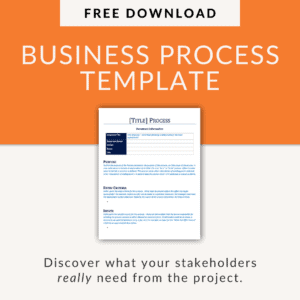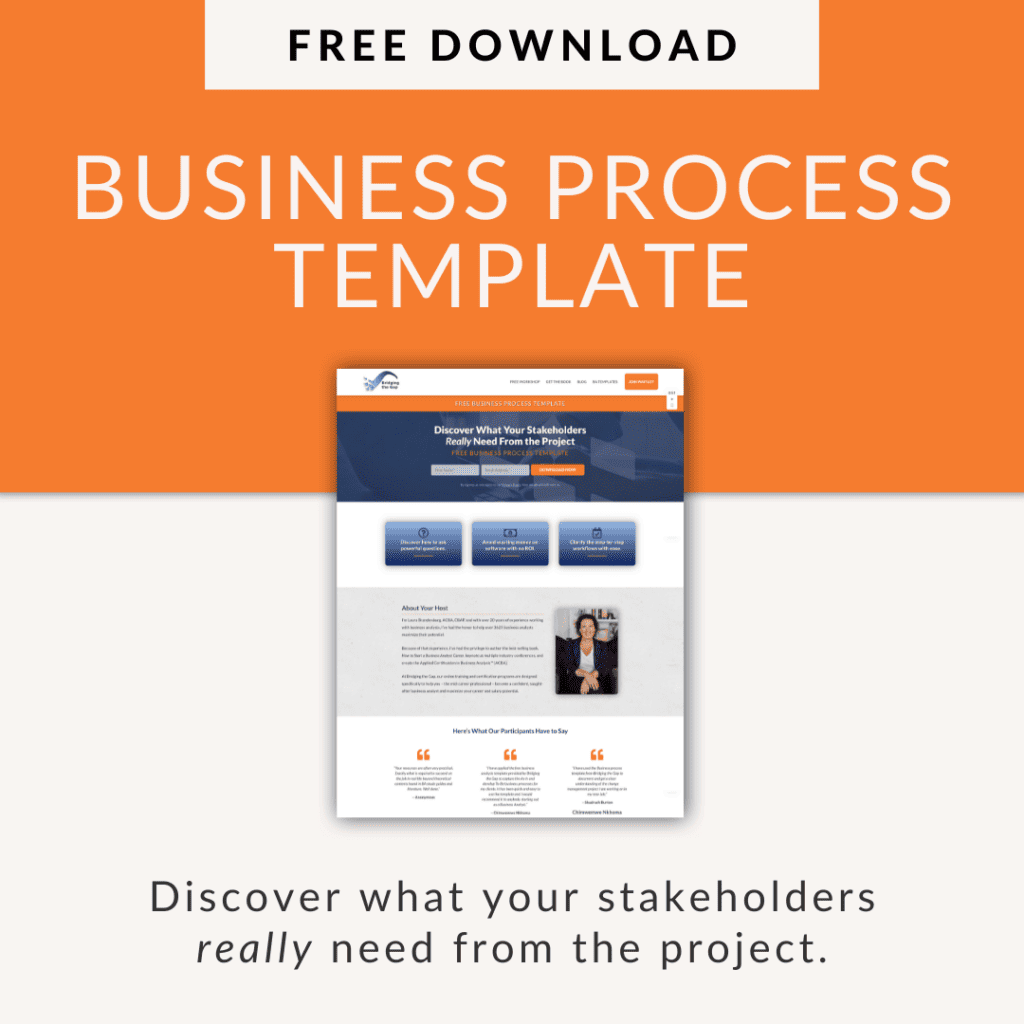As a business analyst, it’s your role to analyze the To Be Business Process and help your stakeholders define how work will flow once the new solution is in place.
In this short video, you’ll discover:
- The definition of a To Be Business Process
- How to analyze a To Be Business Process
- Where to start in your analysis
- What type of collaboration to expect
Download Your Free Business Process Template
At Bridging the Gap, we are all about helping you succeed as a business analyst, no matter where you are in your career. That’s why we’ve created a Business Process Template you can download for FREE.
In this template, you will discover how to:
- Help business users from multiple departments clarify their actual step-by-step workflow
- Avoid wasting money on software solutions that don’t solve the right business problems
- Help new business analysts figure out what questions to ask when starting on a new project
Now, Let’s Dive Into Mapping the “To Be” Business Process
Is your organization rolling out a new technology that impacts the business or developing a new product or service that your organization needs to figure out how to deliver? If so, as a business analyst, it’s your role to analyze the To-Be business process and help your stakeholders define exactly how work will flow once that new solution is in place.
Stay with me and I’ll share exactly how to do just that.
Hi, I’m Laura Brandenburg with Bridging the Gap, where we help you start, succeed, and excel in your business analyst career with weekly videos on business analysis tips and techniques.
Today we’re going to be discussing the To-Be business process and how business analysts can analyze different organizational processes to help improve the business operations and provide more clarity to all members of the organization.
Definition of a “To Be” Business Process
First, let’s start by defining what a To-Be process is. A To-Be business process defines the future state of a business process in an organization.
Typically, the analysis goal in putting together the future state process is to clarify how the business process will work at some point in the future once changes have been made in the organization. And those changes could be business changes or technology changes.
How to Analyze a “To Be” Business Process
So a To-Be business process contains all of the sections in a typical business process model – a description, a list of rules, a list of steps and exceptions, a process map, perhaps even some business rules. To get a rundown of these elements, you can download our business process template. It’s absolutely free.
When it comes to defining the future state, it’s really important for you, as the business analyst, to bring some structure to that business analysis process. Often these discussions can really start to go all over the place without a defined structure. When we’re talking about the To-Be, it’s like anything goes and conversations start to fly all over the map.
Getting ALL the Stakeholders Involved is Key to Success Process Definition
To start defining the To-Be process, you’ll want to start by involving all of the key stakeholders that are involved in the process today, or that you anticipate will be involved in the process in the future. You should have at least one stakeholder representing each functional area or role impacted by the process.
Most often it makes sense to start by analyzing the As-Is business process so that the entire team is aligned around the current state before defining the future state. I did a video recently on the As-Is business process that you can watch below.
If, today, your team is using a spreadsheet and email communication to manage a process and in the future we’re hoping to use a tool or some sort of software system, you want to get clear on how that flows first. How does the spreadsheet and email communication flow and who all is involved as a starting point so that you know exactly what to automate.
To Analyze a To Be Process, Start with Why
Next, you want to be clear on what problem you are trying to solve by updating the process.
- What is the “why” for the project?
- What’s the desired outcome?
For example, your sponsor may want to make the process more efficient, reduce errors, or take advantage of efficiencies created by new technology solutions that could automate all aspects of that process. With the right stakeholders involved, the current state understood, and your desired outcome or where you’re headed defined, it’s actually defined what this future state process is going to be.
Again, this is a collaborative effort between the business analyst and the stakeholders. As a business analyst, you never have all the answers. You can suggest ideas, you can propose solutions, but you really need to involve your stakeholders in the process of defining the process. It’s a little Meta.
If you are having trouble getting stakeholders engaged, here’s a video with a lot of tips on building stakeholder engagement.
To Discover the “To Be”, Use the “As Is” as a Starting Point
As a business analyst, you may want to bring in that As-Is business process documentation as a starting point or maybe even just the high level process map and mark it up with some suggestions and opportunities. This way everybody has something to start from. It helps keep the meeting focused on what the desired outcome is.
For a Truly Brand-New Process, Start with the Goals for the “To Be” Business Process
But if this is a completely new process, you would start by defining the beginning and the ending of the process.
What’s true when this process starts and what needs to be true when it’s done or complete?
That way you’re really clear on scope and then you can just start visually mapping out the steps in between.
Often you need to get to that fully fleshed out business process template. But you would start with a process map so you’re just looking at the high level and starting to map in those pieces in those steps. You can then rework it and move it around.
Often what happens, there’s a lot of rework and splitting apart and breaking things apart into multiple processes or combining them back together as you go through that process.
If you are looking for some tips on process maps, specifically, I also recently recorded a video on that topic, and I invite you to watch it.
Expect a Fair Amount of Collaboration When Analyzing a To Be Process, Including Technical Stakeholders
Now, one thing to note is if your To-Be process is heavily technology dependent, you may need to have a technical stakeholder available to explain how the technical system works and what opportunities there are, what the potential configurations are, and what’s really possible given the technology solutions you have.
This is not always just a business-focused activity. Often we need to have a technology expert as well. And this is why you will often see business analyst roles include some sort of technology requirements, like expertise in a specific software system, because they want you to be able to bring that expertise to the meetings as you meet with your business user.
But if you don’t have that expertise, you just need to bring it into your team by involving a technology stakeholder. Not your whole technology implementation team, but somebody who can speak to the possibilities of technology.
Your To Be Business Process Lays the Groundwork for Software or Functional Requirements
Now, you’ve completed the analysis of the future state, or the To-Be process when you, as the business analyst, have thought through all the implications of that future state, and your stakeholders have approved the updated documentation essentially saying, yes, this is how we want the process to work.
Then you are ready to define any software changes in terms of the functional requirements that are needed to support that To-Be process and start building organizational assets that will support the new process, like templates or training.
Analyzing functional requirements is an entirely separate topic, and here’s a video introducing the key concepts:
If all of this seems like too much, again, don’t worry, you don’t have to start from scratch. We have a free business process template that you can download today to help you get users from multiple departments on the same page about clarifying their desired workflow. This download can even help new business analysts figure out what questions to ask when starting on a new project or a new domain.
For more details on how to use this template to fully analyze a business process, check out this video for a complete tutorial:


